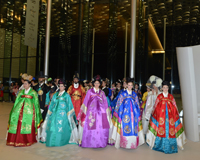Contact Center
.
23 October 2013
Korean Traditional Costumes Show celebrating Korean National Day in Manama


Hanbok, or Korean traditional clothing, has become increasingly popular among foreigners. Color and design were typically luxurious and the hanbok was particularly highly valued for its gracious and subtle colors. Indeed, Bahrain and South Korea are giving a strong impetus to their relations following a breakthrough exchange of high-level visits, a South Korean diplomat has said. Immediate plans to bolster ties included holding a fashion show featuring traditional Korean costumes at the Bahrain National Theatre and a weeklong South Korean film festival in the Bahraini capital, Manama.
The fashion show will be an attempt to bring Korean culture closer to Bahrain in the presence of H.E Shaikha Mai Bint Mohammad Al-Khalifa, Minister of Culture and H.E Yu Joonha, chargé d'affaires of the embassy of South Korea. The show, held in cooperation with Ministry of Culture, is part of the South Korean national day celebrations, was attended by many diplomats and lovers of traditional costumes.
The hanbok is colored using natural dyes. The colors of nature are imbued in the cloth. For example, red dye is obtained from the petals of red flowers. The color pigment is extracted by grounding the petals in a mortar, putting them in a jar and rinsing them with hot caustic soda. It is a very slow, complicated, precise process. The colors obtained in this way differ greatly from artificial dyes in their color and depth. The Hanbok is creative and emotional in its design. The hanbok has subtle curves and simple lines. The sleeves of the blouse open up like wings, while the skirt flares out from the bosom and flows elegantly to the floor. Accentuating the breastline is an unusual type of bow, with its two ends trailing out from the knot and down the front of the blouse, nearly reaching the ankles.
Many hanboks also have beautiful geometric and floral designs embroidered around the cuffs and the neckline of the blouse as well as on the skirt. Yes, the hanbok’s proportions, lines, and colors all combine to make it elegant indeed.. The traditional attire is not form-fitting but rather free-flowing, so that it is convenient to wear, no matter one’s body type. The cut of the design differed noticeably depending on the wearer’s social status or occupation. Someone in the lower class, who was likely to perform more manual labor, would typically wear relatively shorter jeogori with wider sleeves to maximize comfort while working.
The most noticeable change was the addition of the otgoreum, the bow tied in front of the chest, which replaced the previous practice of tying a waistband with long sashes. The otgoreum is one of the most popular elements of the Hanbok today. Almost 70 costumes were exhibited in Manama to give Bahrainis an idea about the historical traditions of Korean clothing. Koreans have traditionally lived as one with nature, and obtained all material from natural sources for making cloth and coloring it. Koreans favor smooth curves rather than straight lines and that has added a gracious line to the hanbok. In fact humanity heritage has no limit when it embraces a lovely music symphony.







